 Image Courtesy:newindianexpress.com
Image Courtesy:newindianexpress.com
Ramdas Athawale, the Social Justice and Empowerment Minister has informed the Rajya Sabha through his written answer on July 28, that no deaths pertaining to manual scavenging has been reported in the last five years. Interestingly, this answer by Ramesh Athawale contradicts his own written reply dated February 2, 2021, where he had stated that the reported number of deaths stood at 340 across 19 States, with Uttar Pradesh topping the list at 52 deaths, as reported previously by SabrangIndia.
Therefore, this tone-deaf response of the Centre is nothing less than an insulting slap in the face of people, especially those hailing from the marginalised communities who are forced into doing this dehumanising work, despite it being banned under the Prohibition of Employment as Manual Scavengers and their Rehabilitation Act, 2013.
The Ministry has also provided state wise details of the total number of manual scavengers in the country which stands at 66,692. The state with the highest number of workers is Uttar Pradesh (37,379) and the lowest figure comes from Chhattisgarh (3). The data provided by the Centre is incomplete as it covers merely 17 states. Some more figures are as follows:
SabrangIndia has extensively reported on the issue of manual scavenging and deaths caused due to this inhuman practice.
In April this year, the Odisha High Court in a suo motu case related to the death of two young men in Cuttack, during manual scavenging, very strongly observed that, “The shameful practice of making persons belonging to the underprivileged and poorest sections of Indian society undertake the hazardous manual cleaning of sewers and septic tanks continues unabated notwithstanding the enactment of the Prohibition of Employment as Manual Scavengers and their Rehabilitation Act, 2013. It shocks the judicial conscience, as it should the society’s collective conscience.”
The Karnataka High Court has also been seized with this matter related to the death and rehabilitation of scavengers. In one of the hearings of a petition filed by All India Council of Trade Unions (AICTU) and High Court Legal Services Committee in March this year, the High Court took note of the grim situation and opined that it had become ‘crystal clear’ that the manual scavenging act has not been implemented properly in the state, as we had previously reported. The Division Bench headed by the Chief Justice AS Oka of the Karnataka High Court had also held that the practice of manual scavenging is inhuman and that it infringes the fundamental rights guaranteed under Article 21.
Two people died of asphyxiation on February 26, 2021 while cleaning a sewage tank in Chennai, Tamil Nadu, bringing the total death toll due to manual scavenging to six in just the month of February! Earlier, on February 14, three persons had died in Kancheepuram district due to the same reason, followed by yet another death of a worker cleaning sewage from a 30-feet deep well in Chennai on February 17.
More damning evidence of gov’t apathy
Another question was posed to the minister with respect to assistance provided to manual scavengers over the last 5 years. In the year 2020 to 2021, only 14,692 workers out of the overwhelming number of 66,692 have received a one-time cash assistance of Rs.40,000 for rehabilitation. This number was even less between 2019 to 2020 wherein only 13, 246 workers received financial assistance. Between 2020 to 2021, states like Bihar, Gujarat, Chhattisgarh and Kerala offered no assistance.
Furthermore, the numbers are even more shockingly low in 2017-2018 at just 1,171 workers, and in 2016-2017 at 1,357 workers. In the year 2018-2019, as many as 18,709 manual scavengers received one time assistance, but this number also remained shockingly low in comparison to the total number of manual scavengers in the country. Arguably, the total number of manual scavengers is way more than what has been projected, taking all states and Union Territories into account.
Last year on World Toilet Day (November 19), the Government of India had announced their aim to eliminate manual scavenging across the country by August 2021. Launching the Safaimitra Suraksha Challenge at a webinar in New Delhi, Shri Hardeep Singh Puri, Minister of State, Independent Charge, Ministry of Housing and Urban Affairs, had said, “We are today setting another milestone by launching the Safaimitra Suraksha Challenge which aims to ensure that no life of any sewer or septic tank cleaner is ever lost again owing to the issue of hazardous cleaning.”
But we are far from solving the problem as the Centre with this response, refuses to even accept that there is a problem. Despite Indian laws deeming manual scavenging illegal, it remains to do very little for the workers and most importantly their safety.
The answer may be read here:
Related:
Shocks the judicial conscience: Odisha HC on death of four manual scavengers
Two manual scavengers die in Chennai, death toll at six for this month alone!
Manual Scavengers: 340 deaths, yet Centre has no intention to make stricter laws!
Govt aims to eliminate manual scavenging by August 2021
Death of manual scavengers: Karnataka HC takes note of the grim situation
Death by excreta: The cursed lives of India’s manual scavengers